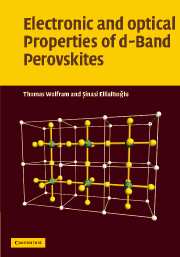Book contents
- Frontmatter
- Contents
- Preface
- 1 Introductory discussion of the perovskites
- 2 Review of the quantum mechanics of N-electron systems
- 3 Empirical LCAO model
- 4 LCAO energy band model for cubic perovskites
- 5 Analysis of bands at symmetry points
- 6 Density of states
- 7 Optical properties of the d-band perovskites
- 8 Photoemission from perovskites
- 9 Surface states on d-band perovskites
- 10 Distorted perovskites
- 11 High-temperature superconductors
- Appendices
- Index
11 - High-temperature superconductors
Published online by Cambridge University Press: 23 December 2009
- Frontmatter
- Contents
- Preface
- 1 Introductory discussion of the perovskites
- 2 Review of the quantum mechanics of N-electron systems
- 3 Empirical LCAO model
- 4 LCAO energy band model for cubic perovskites
- 5 Analysis of bands at symmetry points
- 6 Density of states
- 7 Optical properties of the d-band perovskites
- 8 Photoemission from perovskites
- 9 Surface states on d-band perovskites
- 10 Distorted perovskites
- 11 High-temperature superconductors
- Appendices
- Index
Summary
Background
In 1986 Bednorz and Müller [1] made the surprising discovery that the insulating, ceramic compound, La2CuO4, was superconducting at low temperature when suitably doped with divalent ions. In fact, all of the members of the class of copper oxides, La2–xMxCuO4 (where M is Ba2+, Sr2+, or Ca2+ ions), were found to be superconducting for x in the range, 0.1 ≲ x ≲ 0.25. At optimal doping of x ≈ 0.15, the superconducting transition temperature, Tc, of La2–xSrxCuO4 was about 38 K.
Since 1986 there has been an enormous scientific effort focused on copper oxides with similar structures. Over 18 000 research papers were published in four years following Bednorz and Müler's report. As work progressed around the world, new compounds were discovered with higher Tc's. In 1987 doped samples of YBa2Cu3O7 (“YBCO”) were found to be superconducting at 92 K, thus becoming the first superconductors with Tc higher than the boiling point of liquid nitrogen (77 K). Recent studies [2] on mercuric cuprates report Tc in excess of 165 K.
A very brief list of some of the most studied high-temperature superconductors (HTSC) and their transition temperatures is given in Table 11.1. In column two “alias” refers to the frequently used name of the undoped, “parent” composition. For example, Tl1223 refers to: one Tl, two Ba, two Ca, and three Cu atoms. The tetragonal structure for the La2CuO4, is shown in Fig. 11.1(a).
- Type
- Chapter
- Information
- Electronic and Optical Properties of d-Band Perovskites , pp. 249 - 284Publisher: Cambridge University PressPrint publication year: 2006



